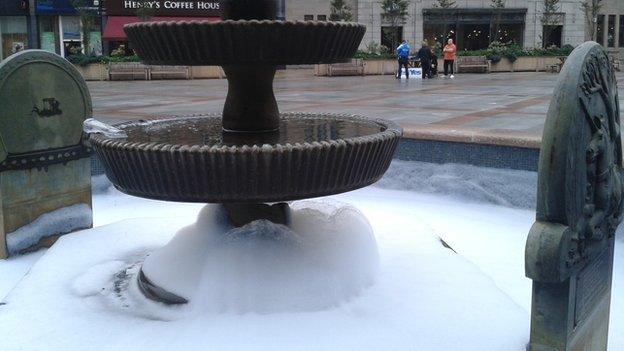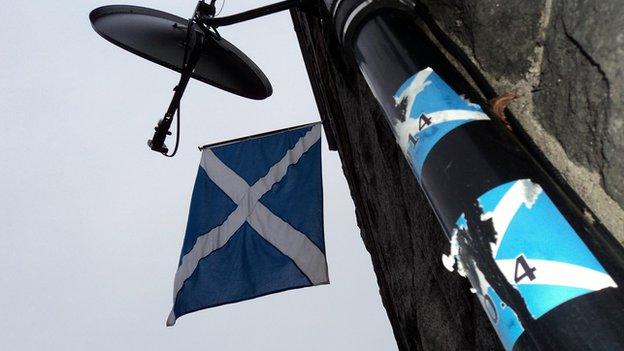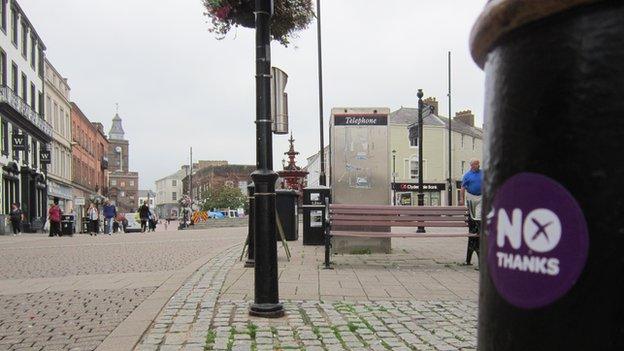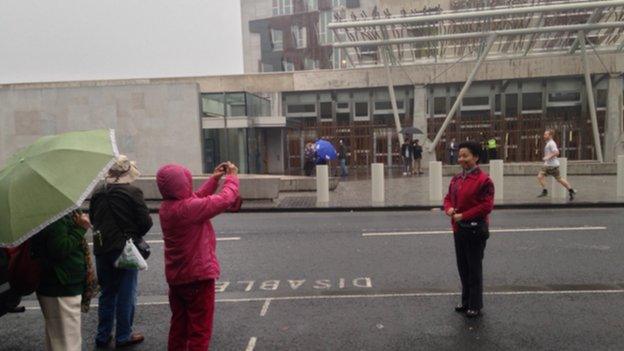Scottish referendum: The morning after the No before
- Published
Scotland woke on Friday morning, if it even went to bed, to a new political landscape. Both sides of the referendum debate agreed that the country would never be the same again. Pictures from the count were beamed around the world, but how did it look on the streets up and down Scotland? BBC Scotland Online's regional reporters give us their view.


Bubbles in the fountain but there was no bubbly for Yes voters in Dundee
Philip Sim
Tayside and Central Scotland reporter
They spiked the fountains with bubble bath in anticipation of a party in what was dubbed Scotland's "Yes city". But this morning only a hardy few supporters of Scottish independence remained in Dundee's City Square.
Yes supporters passing by described the result as "rubbish", "depressing", and even "a dark day for Scotland", although many say they are proud to belong to a city that backed independence with a strong majority of 13,000.
A few days ago it was impossible to leave the square without a leaflet or a flyer from one campaign or the other, often from the canvassers buzzing around the Yes Scotland stall which had become a near-permanent installation.
And while there's still the odd Yes badge in evidence, today the dreary weather reflects the flat feelings of many of the city's people.
There's little jubilation on show from No voters either, with people on both sides saying they just want to move on and see what additional powers might be transferred north from Westminster.
One man told how he voted no because he's lived in the United Kingdom for 80 years and feels safer that way - but immediately spoke passionately about wanting Scotland to take more control over taxes and income from the oil industry.
Turnout at recent elections in Dundee had threatened to fall below 50%, but it skyrocketed to more than 78% for the referendum - it's clear there's a reborn hunger for politics in the city.
Negotiations over the future of Scottish devolution will be keenly watched from Tayside.


George Square in Glasgow was bustling during the campaign but eerily quiet on Friday morning
Nick Eardley
Glasgow and West of Scotland reporter
Glasgow's Buchanan Street feels very different this morning.
For the past week, it has been full of activists, fighting to get their message across. It seemed like every second person was wearing a campaign badge - most of them Yes, but a significant number of No badges too.
Just 48 hours earlier, Yes campaigners were jubilant as they stood outside the Glasgow Royal Concert Hall to hear Blair Jenkins declare his confidence they would win.
This morning, under grey skies, there is almost no sign of the referendum, with the exception of some discarded campaign material. Not a single person wearing a campaign badge was visible. Even a pro-independence sticker, cheekily stuck to a statue of Donald Dewar, the architect of devolution, has been removed.
A few minutes away is George Square. For the last three nights, thousands of Glaswegians have gathered there to show their support for independence. On Friday morning, just a couple dozen remain; the ecstasy of a vibrant campaign replaced with desolation.
Andrew Mansell, 21, from the city's Southside is one. He says he is "devastated" by the result.
"We bottled it at the only opportunity we had", he says.
Some people say they are happy at the result. Debbie Durnen, 49, is one, but she does admit the atmosphere has changed. That is in part because No voters have been more reserved, she says: "I would say that quite a lot of No voters are like that".
Friends Steven Carson, 19, and Daniel Salked, 21, both say they are "quite happy" at the outcome of the vote. They too agree the atmosphere in this city has changed. "It is a bit dead", Daniel says. "Most people are unhappy about it. Most of them are Yes voters."
The atmosphere that made this city such an exciting place to be in the run up to Scotland's vote is gone. Business as usual perhaps doesn't need the same fanfare. Central Glasgow is back to normal.

.jpg)
Peering through the gloom, the Flora Macdonald statue outside Inverness Castle
Steven McKenzie
Highlands and Islands reporter
In Inverness, the fast food outlets were doing a roaring trade with those in need of an early morning caffeine hit.
Everyone seemed to have a takeaway cup in hand as they briskly walked to work, maybe needing the jolt of coffee or tea to wake them up after staying up all night to watch the referendum results.
There can be no doubt that this city, and other places across the Highlands and Islands, have been gripped by the debate.
Countless lamp-posts, bus stops, windows of houses and flats have been plastered with placards, stickers and posters for "Yes", and in the later stages of the campaigns material saying "No Thanks".
Even the Loch Ness Monster was drawn into the debate.
A wooden sculpture of the legendary beast, a landmark on a roundabout on Inverness' Dores Road, has had a sign on it saying: "Yessie".
Back in the city centre, another icon of this region seems to be peering into the thick morning mist searching for answers to what the result of the vote might bring in the future.
Flora Macdonald, well, a statue of her, stands tall outside Inverness Castle. With a hand raised to her forehead, she gazes south west towards Loch Ness and the hills beyond.
In life, she played roles in the last Jacobite Rising and later in the British effort to suppress American Patriots' fight for independence.
The part she played in helping Bonnie Prince Charlie evade capture after the Battle of Culloden in 1746 is celebrated in song.
But maybe less well-known is that, after emigrating to North Carolina in 1774, she supported her husband Allan, an officer in the Loyalist forces fighting alongside the British against American revolutionaries.
Before one battle, she is said to have spoken of the loyalty, bravery and sacrifices of Scots, before mounting a snow-white horse and saying farewell to her husband.
The battle ended in defeat for the Loyalists.
On the road below Macdonald's statue it was business as usual. It was busy with commuters in cars and on bikes, delivery trucks and buses.
One motorist driving by still had a vote "Yes" sticker on their windscreen, a defiant show that they were not quite ready to give up on that fight.
For others there might be a distraction from the chatter and debate over what happens next.
Some time in the last few days, a Christmas shop appeared on the High Street.


A solitary Saltire flies in Wallfield Place in Aberdeen
Ken Banks
North East Scotland and Northern Isles reporter
In Aberdeen, many of the Saltire flags which had been in evidence in the run up to the count were no longer in evidence on Friday morning.
The streets also seemed strangely quiet.
One flag, however, could still be seen flying in Wallfield Place in the city's Rosemount area.
There were also still some "Yes" stickers on windows and lamp-posts.
The vast wealth associated with the North Sea oil and gas industry was one of the fiercest areas of debate during the referendum campaign.
So it was perhaps ironic there were reports yesterday of offshore workers being unable to fly home on polling day to cast their vote due to weather issues.
However, the north east of Scotland delivered a decisive "No" vote so it may have been academic whatever way any such votes would have been cast.


Dumfries and Galloway voted strongly to reject Scottish independence
Giancarlo Rinaldi
South of Scotland reporter
The feeling in the heart of Dumfries town centre appeared to reflect the result delivered in the ballot boxes of southern Scotland.
There was more delight than disappointment at the outcome of the Scottish referendum.
"I was quite pleased," one woman walking towards the town's Midsteeple admitted. "We would have managed fine if we had been on our own - there is no doubt about that - but I think we are best the way we are in the end."
In fact, "better the devil you know" was the theme of a number of others who stopped on the High Street's cobbled stones to give their opinions.
In an area where about two-thirds of voters rejected Scottish independence, this was hardly surprising.
"I have mixed feelings," added a local businessman. "I know a lot of people are waking up today feeling very upset and disappointed but I hope we can go back to the way we were before."
Not everyone, however, was willing to take the outcome lying down.
One Yes voter used classic sporting terms to sum up his emotions about how the vote had gone.
"We were robbed!" he cried. But the majority of those living around him seemed to be much happier with the result.


The Scottish parliament was practically deserted apart from a few tourists
Angie Brown
Edinburgh, Fife and East Scotland reporter
Drizzly damp weather and a sense of exhaustion enveloped Edinburgh's streets as the capital city woke up to a "No" vote to Scottish independence.
The Scottish parliament, which had hundreds of campaigners outside only hours earlier, was deserted.
The only signs of life were tourists taking pictures and the floodlights of the neighbouring media tent.
The parliament seemed stubbornly quiet against a backdrop of Arthur's Seat, which was shrouded in mist.
Around the corner in the Royal Mile, some late night supporters were drinking coffee in cafes and tourists carried on their sightseeing tours huddled under umbrellas and ponchos.
Campaign posters and notices have been taken out of shops and there were no Saltires hanging from flat windows.
A passerby said although he had voted "No" he felt a tinge of disappointment as he walked through Edinburgh's street to get to work as the "excitement had gone".
Everything seemed to be back to normal.